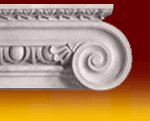The morality play developed during the Medieval period.[2] The morality plays attempted to educate via entertainment. It is thought that the Dominican and Franciscan orders of
Christian friars developed the morality play in the 13th century by adding actors and theatrical elements to their sermons.[3] By doing so, the (mainly illiterate) masses could more easily learn the basics of Christianity through dramatic spoken
word. This made complex topics such as original sin and atonement more easily understood. By personifying vices, virtues,
the Devil and the Good Angel, stories of temptation were made accessible to those who were unable to read them themselves.[4]
The main theme of the morality play is this: Man begins in innocence, man falls into temptation, Man repents
and is saved.[5] The central action is the struggle of Man against the seven deadly sins that are personified into real characters (prosopopoeia).[4] It is believed that the allegory of vices and virtues fighting over Man’s soul goes back to the 4th century Roman
epic, Psychomachia.[6] This allegorical application of theatre to Christianity is intended to help the audience understand the greater concepts
of sin and virtue.[7] The three greatest temptations that Man faces in morality plays are The World, The Flesh, and The Devil.[8] It is stressed that “Sin is inevitable” but that “repentance is always possible”.[9] Morality plays were not holiday-specific; they could be performed at any time of the year, as repentance occurs at
any time of the year.[10]
Characteristics
Morality plays typically contain a protagonist who
represents either humanity as a whole or a smaller social structure. Supporting characters are personifications of good
and evil. This alignment of characters provides the play’s audience with moral guidance. Morality plays are the result
of the dominant belief of the time period, that humans had a certain amount of control over their post-death fate while they
were on earth.[11]
In Everyman, perhaps the archetypal morality play, the characters take on the common pattern, representing broader ideas. Some
of the characters in Everyman are God, Death, Everyman, Good-Deeds, Angel, Knowledge, Beauty, Discretion, and Strength.
The personified meanings of these characters are hardly hidden. The premise of Everyman is that God, believing
that the people on earth are too focused on wealth and worldly possessions, sends Death to Everyman to remind him of God's
power and the importance of upholding values.[12] The emphasis put on morality, the seemingly vast difference between good and evil, and the strong presence of God makes
Everyman one of the most concrete examples of a morality play. At the same time, most morality plays focus more on
evil, while Everyman focuses more on good, highlighting sin in contrast [13]
Other plays that take on the typical traits of morality plays, but are rarely given the title of "morality
play" are Hickscorner and The Second Shepherds' Play. The characters in Hickscorner are
Pity, Perseverance, Imagination, Contemplation, Freewill, and Hickscorner. They blatantly represent moral ideals.[14] In The Second Shepherds' Play, the characters are less obviously representative of good and evil, being
primarily a trio of shepherds. But other characters such as Mary, The Child Christ, and An Angel show a strong moral presence
and the importance of God in the play.[15]
Justice and Equity as characters
In early English dramas Justice was personified as an entity which exercised “theological virtue or grace, and was concerned with the divine pronouncement
of judgment on man”.[16] However, as time progressed, more moralities began to emerge; it is during this transitional period where one begins
to see Justice begin to assume more and more the qualities of a judge. The Justice in Respublica begins to concern himself with
administering justice on “the criminal element”, rather than with the divine pronouncement on a generic representative
of mankind.[17] This is the first instance where one may observe a direct divergence from the theological virtues and concerns that
were previously exerted by Justice in the morality plays of the fifteenth century. The Justice in Respublica is
personified as a “civil force rather than a theological one”.[17] An evolution of sorts takes place within the morals and agendas of Justice, he begins to don on the Judicial Robe
of prosecutor and executioner.
Another change envelops in the character of Justice during the sixteenth century in morality
plays;
Equity replaces Justice and assumes the judiciary duties previously performed by Justice.

